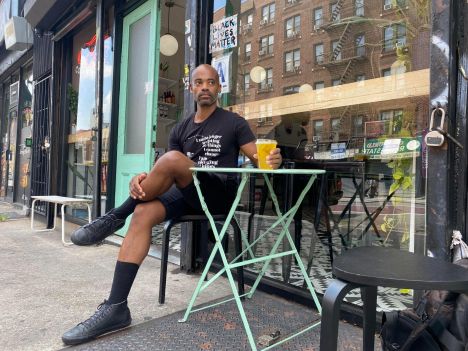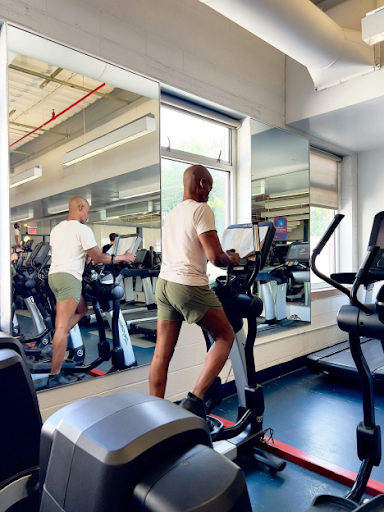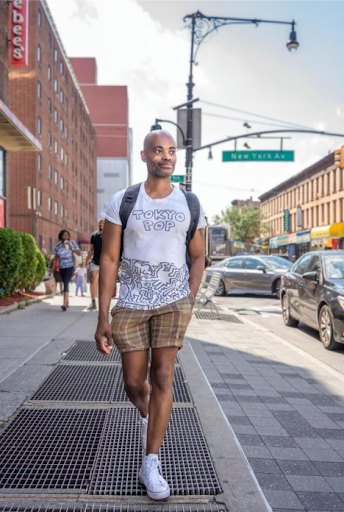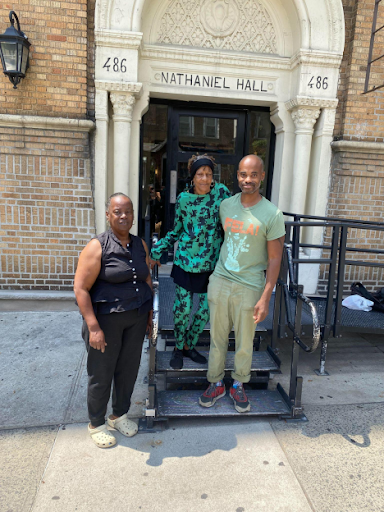
I recently looked around the YMCA in Bed-Stuy, Brooklyn, where I’ve worked out for over 10 years. I counted the number of Black people there, including me. Four. And 23 white folks.
These numbers used to be reversed. There’d be Black faces everywhere. Older folks with traces of a Southern accent greeted me: “Good morning. How you feeling?” The weight room boomed with Black voices — sports statistics and political opinion piled on top of each other.
These days, it’s often quiet except for dropped weights and the hum of earbud music. It’s a different place, but it’s not about these changes as much as it is my reaction to them.
I started questioning the relationship during the pandemic. One day I was on the StairMaster, doing my thing, when a Black gym employee approached a white guy on the treadmill in front of me and told him to pull his mask back up. He gave her a quick glance, slowly tugged the fabric, then returned his focus to running.
There was something about the look I saw him give her: entitlement. Dismissal. Invisibility. It triggered an overwhelming urge in me to wipe the smugness off his face.
Just let that mask fall down again.
It wasn’t even about him or the mask, I now realise, but about all the Black people who’ve disappeared.
Bed-Stuy in 2023 is a lot more expensive and a lot whiter than it used to be. Over the last 20 years, the Black population in the neighbourhood dropped from 74.9% to 40.9%, and the white population went from 2.4% to 32.7%. It makes me wonder, where do people go when they’re pushed out of neighbourhoods they’ve lived in for generations? Where was Miss Beverly, the retired schoolteacher? Where were the Caribbean ladies who talked to themselves while looking at fruit in the grocery store?
Thoughts of these people being pushed out had simmered and percolated into deep resentments with no easy or obvious way to address or direct them. Instead, I got mad at people whose presence reflected the absence of those Black bodies.
I was mad a lot.
Why are you asking if they have oat milk in a bodega, you dumbass, I caught myself thinking.
Do you think I’m gonna move out of the way cause you’re oblivious to the space you’re taking up on the sidewalk (in the world)? Nah, bruh.
I liked the anger. It provided access to what felt like a superpower, which began with a small flush in my chest and quickly spread to heat up the rest of my body. It was like doing drugs when you’re an addict: You know how it’s going to end, but you also know one hit will bring what feels like the strength to vanquish your fears for a little bit. That’s what I was feeling in the gym.
I looked at the man the gym employee had confronted just minutes ago. I saw the mask slide past his lower lip.
“Hey! Didn’t she tell you to put your fucking mask on?” I was somehow off the StairMaster, standing next to the man, and speaking at a volume I never used.

I expected, wanted, and needed an apology — for so much. Instead, I got a version of the glance he’d given the employee. I wasn’t about to let it end like that, but then I saw past him to the mirror behind the treadmills. I looked crazy.
How did I become this person? I asked myself. Yeah, he’s probably an asshole, but gyms are full of assholes. So what?
The difference is he was an asshole and a gentrifier, and I needed to separate myself from him and what he told me about myself.
They were at the gym, the markets and the cafes. I saw them because I was in those same spaces, sometimes one of the few Black people there. There was no Miss Beverly sitting across from me inside here, and it could feel like crossing a racial picket line to order a latte.
I remember when an older Black woman joined me on the street as I was reading the outdoor menu of a new restaurant. “Nice,” she said. “Too bad it’s not for us people, right?”
I laughed along with her, trying to hide my embarrassment that I was excited to try the food. I felt like a sellout: a Black guy from a mostly white Massachusetts town still trying to straddle two lines of his identity.
There have always been light-skinned Blacks who passed for white, leaving parts of themselves behind for a lottery ticket promising a chance to breathe with ease. I was a lower-middle-class mocha-hued kid who couldn’t pass, but I taught myself to code-switch and adapt to the rules of the class who ruled. I felt like I’d won that jackpot when eyes widened as people tried to reconcile my vocabulary with my Blackness ― and then my temples would throb. My need to win them over doused me in shame.
Why did I need their approval? Because though I’m an adult who writes and creates art about Blackness and bias, and though I’ve talked in front of hundreds of people about the subject, I’m also the child who slapped himself over and over in the mirror because of his big lips, and his wide nose he’d learned was ugly.
After the treadmill interaction, I thought about another gym incident, also regarding a mask, a few months before. I was in the weight room when I heard, “Hey, bro, can you put your mask over your nose?”
The Black guy on the butterfly machine looked over at the white guy talking to him. “Nah. I’m good,” he said.
“Huh? You do know there’s a pandemic, right?” the white guy asked.
No response. The Black guy went back to pulling those bands and breathing heavily.
Now you know what it’s like to be ignored, I had thought at the time.
It escalated into an adrenaline-fuelled argument, and a Black staffer was asked to intervene.
“Could you tell him to put his mask on? It’s the fucking rule in the gym,” the white guy said.
I knew the conflict going on in the staff member’s head: How can I side against another Black person in this space? They averted their eyes and walked away.
I had barely talked to the other Black guy in all the years I’d seen him around, but now we looked at each other and slowly nodded.

Why did I act like that then and now had a completely opposite reaction? It made no sense, except it did: The anger was also a deflection from all the ways I still prioritize whiteness.
My old therapist called it my “New Yorker syndrome.” I’d be on the subway, conscious of how my Blackness was being sized up as people entered the train and, upon seeing me, chose to sit elsewhere.
I’d have the urge to reach in my bag for something to read — to convey my intelligence and relatability. I love to read The New Yorker, but in those moments, I’m using it as a shield to protect myself from the empty seat next to me, which serves as a reminder that my mere existence is a problem.
It’s ingrained in us to prioritise the white gaze. When someone is arrested for a particularly bad crime, pretty much every Black person I know, regardless of their background, has the same response: “Please don’t let them be Black.” But what many of us are also thinking is, “Why are you making the rest of us look bad?”
It’s respectability politics, sure, but there’s no way not to absorb the institutional, educational and political conditioning that’s beaten into us — sometimes literally — from childhood. “White is right” is the default. Everybody else is a satellite orbiting a white sun, and displeasing or challenging white authority carries consequences.
When my brother was in high school, a table of white students in the lunchroom called his table of Black friends “niggers,” which didn’t go over well. Police were called after the fight, but only the Black students were spoken to. Because my brother was “a good kid” and the captain of the football team, there wasn’t a mark on his record. He was told that people call the police “pigs” and they brush it off, so he should learn to ignore “nigger.”
“The difference,” my brother told them, “is you can take off your uniform, but I can’t take off my color.”
Many Black people have been saved from punishment and consequences because they’re “one of the good ones.” And many more have suffered because of their poverty, how they spoke, their education (or lack thereof), or how different their lives were from the accepted ways of existing.
Respectability is a uniform I remove at night, alone in my bedroom. Only then do I realise how tight it is. I both exhale and stiffen, knowing I shouldn’t get too comfortable, because I’ll probably put it on again tomorrow.
It shows up in many parts of my life. Choosing the white guy over the Black one on Grindr, and telling myself his race had nothing to do with it. Making assumptions about another Black person based on how they speak. Taking out that issue of The New Yorker.
I feel the warmth of anger following those moments, and it’s looking for a place to land far away from me.
Why did he come back to check his lock when I walked into the locker room?
You do know I’m in between sets, right? How dare you come over here and change my weights like you don’t see me.
Microaggressions are real, and my gym, the neighbourhood, and the world are full of racial prejudices and assumptions encountered on a daily basis. It’s about how I respond, both to them and to myself — no, my selves. There’s the me who knows that nothing I do will change some people’s perception of me. But there’s also the me who desperately wants to win them over, even though many times I don’t even know who “they” are.

Recently I was talking about all of this with my current therapist, who is Black, queer, and amazing. “Have you ever considered replacing ‘buts’ with ‘ands’?” he asked. “You’re the only one telling yourself you have to fit into rigid categories of behaviour and thoughts.”
Something clicked when he said that. Yes, I push back against gentrification and displacement, and I eat in the ramen restaurant whose arrival means higher rents are coming. I’m a person who’s never been in a physical fight, and sometimes my anger can be so overwhelming it feels volcanic. I’d love more than anything to date another Black man, and I’m scared of it at the same time, knowing they see all parts of me, including the parts I want to hide.
Nobody is completely binary. There are contradictions that can’t be dismissed with a but. There’s fear in knowing this: If I accept that about myself, then it’s probably true of other people, and it’s hard to let go of stereotypes.
In my work, I ask people to take a magnifying glass and look more closely at the ways we see each other, and the conditioning behind it. I realise have to do the same — and it’s uncomfortable as fuck.
I’m rooting for everybody Black in a country that taught me winners rarely look like us. Embracing my Blackness means accepting that since enslavement, respectability could mean the difference between a body humbled and a body extinguished. It’s part of my history, and the history of this country.
I have more questions than answers. I do not know what the future of Bed-Stuy or of the people who live there — or no longer live there — will be. I don’t know what my own future will be, or how I will show up or be understood in any given place on any given day. But I want to keep trying to make sense of it, and of myself. And the times when I root for myself exactly as I am today, without comparing myself to others, are beautiful.
I have a fourth grade class photo on my bedroom wall. That’s when my self-hatred was at its worst. I look at that boy with his big grin before I go to bed and when I wake up in the morning. I tell him: “I’m doing my best today to save us from doing more harm to ourselves.” By “us” I mean me, but also my people.
At times, I still find myself questioning whose side I’m on. The answer is that I am, and always will be, on the side of the boy in the mirror, who internalised some hard truths about how he is seen on the outside — on the streets, in the world, and in the gym — and is trying to find peace on the inside as he makes his way in the world.
Delano Burrowes is a Brooklyn-based writer and visual/performance artist who creates work about the double consciousness of identities. His ongoing art/discussion series, “The Great Barrington Project,” explores how Black people are seen and interpreted. He is the vice chairperson of the Blackyard Collective, a nonprofit mutual aid and support network for queer Black people in recovery. He is also writing a memoir about overcoming crystal meth addiction and internalized racism. For more info, visit his Instagram @theodorehuxtable.